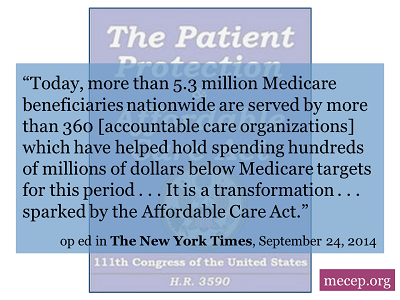Health reform hasn’t only reduced the rate of uninsured to levels not seen since the 1990s; it also is reducing healthcare costs, which ultimately will make healthcare more affordable for everyone. The small city of McAllen, Texas grabbed the national spotlight five years ago as a place where costs and unneeded procedures were out of control. Now, McAllen is making headlines again. But this time, it’s a health reform success story.
 Pre-health reform, Medicare spending per enrollee in McAllen was double the national average. But people in McAllen weren’t twice as healthy. They just received many more specialty medical treatments, at a higher cost. A sick Medicare beneficiary in McAllen was two-thirds more likely to see ten or more specialists in a six-month period; the average McAllen Medicare patient was 200 percent more likely to undergo nerve-conduction testing for carpal tunnel syndrome, and 500 percent more likely to undergo specialized testing for prostate trouble. However, McAllen Medicare patients were actually less likely to receive inexpensive, but effective, preventive screenings and primary care. And their health outcomes were worse than other towns in that region.
Pre-health reform, Medicare spending per enrollee in McAllen was double the national average. But people in McAllen weren’t twice as healthy. They just received many more specialty medical treatments, at a higher cost. A sick Medicare beneficiary in McAllen was two-thirds more likely to see ten or more specialists in a six-month period; the average McAllen Medicare patient was 200 percent more likely to undergo nerve-conduction testing for carpal tunnel syndrome, and 500 percent more likely to undergo specialized testing for prostate trouble. However, McAllen Medicare patients were actually less likely to receive inexpensive, but effective, preventive screenings and primary care. And their health outcomes were worse than other towns in that region.
The McAllen analysis not only made a splash in the media, it caught the attention of Barack Obama. The newly elected president made sure that his advisors kept McAllen in mind as they designed and implemented health reform. The president even invoked McAllen in remarks to the American Medical Association. Something had to be done in this country – not just to help people afford insurance, but to stop the skyrocketing costs of the care covered by insurance.
This week, in a kind of coda to the story released five years ago, McAllen received national attention, but this time for a achieving a 180 degree turnaround: the Medicare Accountable Care Organization (ACO) in McAllen saved $20 million in a little more than a year – while significantly improving patients’ health. Even though Medicare paid less per enrollee, more McAllen diabetics had their condition under control. Elderly patients were more likely to receive flu shots than they had been before the cost-cutting innovation was in place.
Before health reform, Medicare paid doctors and hospitals for each service they performed with no consideration for need, effectiveness, or patient outcome. In recent years, chronic conditions like diabetes, arthritis, high blood pressure, and kidney disease have driven Medicare cost growth. Many of these conditions are avoidable with proper preventive care, and all are cheaper – and less invasive – to treat at the outset. However, the fee-for-service model offered incentivizes to providers to order more costly interventions, tests, and treatments, without regard to whether patients’ underlying conditions improved.
In response, the framers of the Affordable Care Act set up ACOs as an innovative new Medicare payment system. An ACO pays providers more if their patient population is kept well. Systems receive bonuses dependent on the percentage of their patient population whose diabetes is controlled, or screened for cancer. At the same time, a Medicare ACO penalizes systems for unnecessary treatments, such as repeated diagnostic tests or expensive hospital readmissions for people released prematurely from inpatient care.
ACOs forestall the kind of uncoordinated, revenue-driven care that was breaking McAllen and the nation’s health care system. A nationwide evaluation showed that a small pilot group of hospital ACOs has saved Medicare $380 million. Here in Maine, the Bangor Beacon ACO reduced spending per beneficiary by $499. Multiplied across the many ACOs around the country, these savings per enrollee are helping to extend the long-term solvency of the Medicare program. Three years ago, Medicare spent $12,000 per person. Now it spends $11,200, and that cost is projected to keep declining. The 10-year savings connected to this trend amount to $715 billion.
Too often, whatever gets more eyeballs or internet “click throughs” guides the public debate. While the bruising debate over the palatability and timing of health reform dominated the media, burgeoning Medicare costs were threatening to swamp the Treasury. The Affordable Care Act is helping to change that. McAllen, once a basket case, is now a bellwether.


